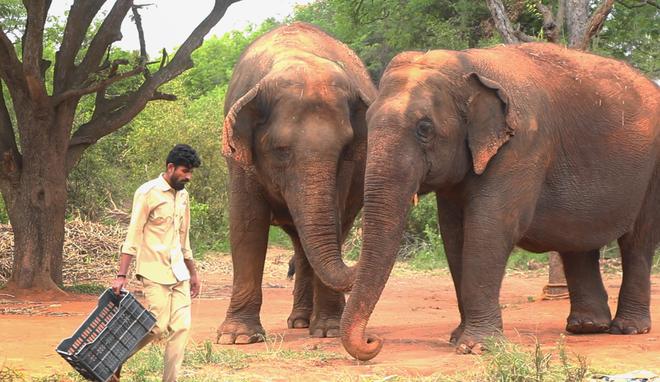
It’s a warm Friday afternoon at the Lakshmisagar Reserve Forest. Vijaykumar V., manager at the Wildlife Rescue and Rehabilitation Centre (WRRC), is walking towards a thicket. “Durga...” he hollers.
From inside the forest, sounds of leaves rustling, branches creaking and twigs snapping emerge. Slowly, from between the trees, appears a big black head with fan-like ears and a long trunk.
Durga, 22-years-old, is one of the six elephants at Karnataka’s first elephant care facility which opened in Malur last year. The facility has completed a year since its opening in September, 2022.
Located on 100 acres of Karnataka Forest Department land, all the infrastructure has been set up by the Forest Department and WRRC, a Bengaluru-based non-profit, takes care of the day-to-day operation.
Durga, Rani, Lakshmi, Janumani, Anisha, and Gowri, all captive elephants once, occupy the facility today where they lead a relaxed life. But a lifetime of captivity has left them with some irreparable damage. At the facility, efforts are on to reverse those as much as possible.
Tales of exploitation
Karnataka boasts of the highest number of elephants in India with the latest elephant census pinning the number at 6,395. According to a survey done in 2019 on captive elephants in the country, there are more than 180 captive elephants in the state.
The survey also found that around three-fourths of the captive elephants in the country are under private ownership. For the jumbos, often, this means abuse, isolation, and exploitation.
From carting tourists up and down the steep forts of Rajasthan to begging on the streets of Delhi and Uttar Pradesh, these majestic creatures have been exploited for commercial and financial gains.
While elephants are social animals, captive elephants often lead an isolated life in constrained spaces. Training methods can be brutal. Rented out to temples for religious festivals or for private ceremonies like weddings and inaugurations or owned by circuses, they are forced to stand in the scorching heat for hours, take part in noisy processions and perform amid jeering crowds.
This not only compromises the animal’s welfare but also puts human lives at risk. Several lives have been lost to instances of elephants running amok during festivals.
Issues in captivity
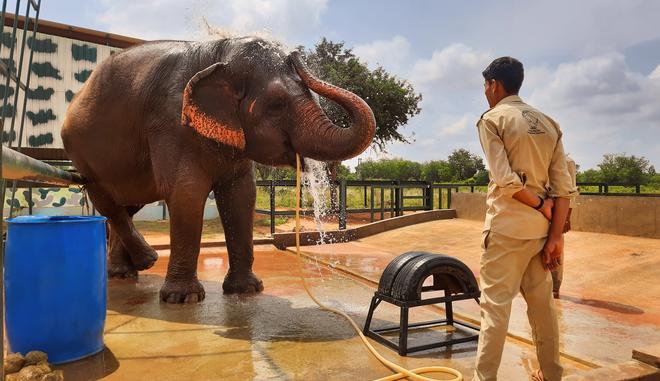
“On seeing the plight of captive elephants in several circus groups, temples, and other such places where they were meted out with ill-treatment, in 2022 Karnataka Forest department, with the help of WRRC, set up the facility to give them the best possible care,” says Yedukondalu V., deputy conservator of forests, Kolar.
He points out that the lack of proper shelter, nutritious food, exercise, and socializing opportunities in captivity leads to physical as well as psychological problems in elephants.
An adult Asian elephant weighs around 5,000 kg and walks about four to ten km a day in the wild. But under private ownership, they are chained and forced to stand long hours resulting in arthritis, cracks on foot, and other deformities.
Almost all rescued elephants at the Malur facility suffer from one or more of these conditions. Some also have deformed spines, while a few are partially blind.
Take the case of Anisha, the oldest at the facility. She was transported to Tamil Nadu from Northeast India for timber logging works initially. Over the course of time, her ownership changed hands multiple times. At one point she was owned by private parties and later by temples. Today, her spinal cord is deformed. All four legs are cemented making it impossible for her to bend them.
Lakshmi, who is the latest joinee, was rescued from Udupi and is partially blind.
Another problem common among captive elephants is obesity. Devotees offering elephants bananas, coconuts and jaggery in temples is a common site. In the wild, the elephants mostly feed on roughages.
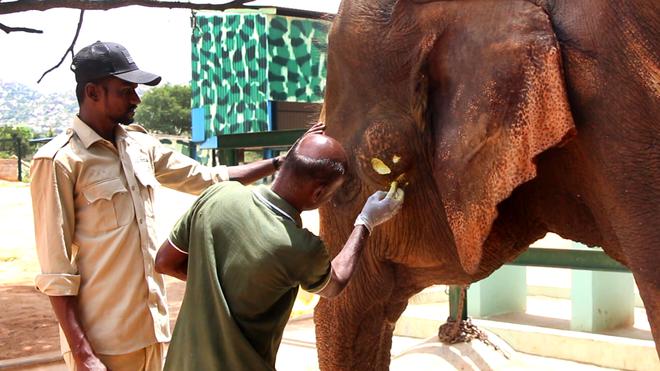
The high sugar content in the food fed by devotees and others to captive elephants results in obesity, foot swelling, heart problems, and issues with the digestive system. High blood sugar also worsens scrapes, bruises and wounds slowing the healing process.
A lesser visible consequence is the mental trauma the animals still carry from their captivity.
“When they see people, they may get agitated sometimes,” Mr. Yedukondalu notes. “For such elephants, some facilities should be there that are managed scientifically.”
Undoing the chains
Anisha has finished her morning shower and is receiving her laser treatment and other medications. The staff feeds her during the process to divert her attention, she keeps devouring the food, but when handed a beetroot, she hurls it away.
“She has become choosy,” quips one of the staff.
At the Malur facility tailor-made treatment is given to each elephant. MRI scans and lab testings have been conducted for all pachyderms. Each elephant is assessed for body weight and body structure, the blood profile is analysed and nutritional deficiency is calculated. Based on that vitamins, roughages, and nutritional food are provided.
The vet visits regularly, does checkups, and notes down the progress of each elephant. Although 20 acres were demarcated for the facility initially, later it was expanded to 100 acres to provide enough space for the elephants to roam around. Within it, there are also two pools which are the favorite socialising spots of the elephants.
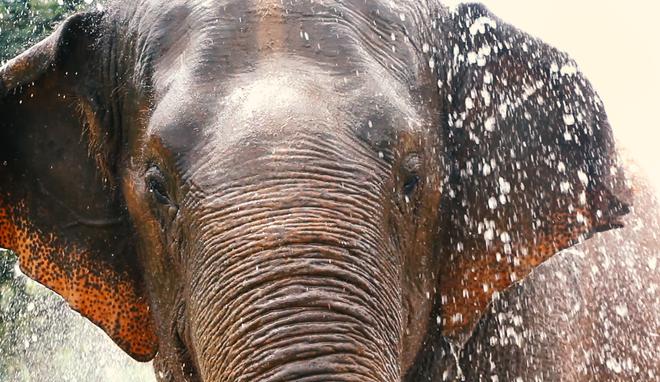
“It’s kind of a second opportunity for the elephants. Generally in India, we don’t have these kinds of facilities. We have camps like Mathigodu and Dubare where the wild animal is captured and trained in order to mitigate man-animal conflict,” notes Mr. Yedukondalu.
The Malur centre is planning to accommodate up to 15 elephants.
The routine
The staff at the centre ensures a regular routine for them which starts at 6am in the morning. Vijaykumar V., manager at the facility explains.
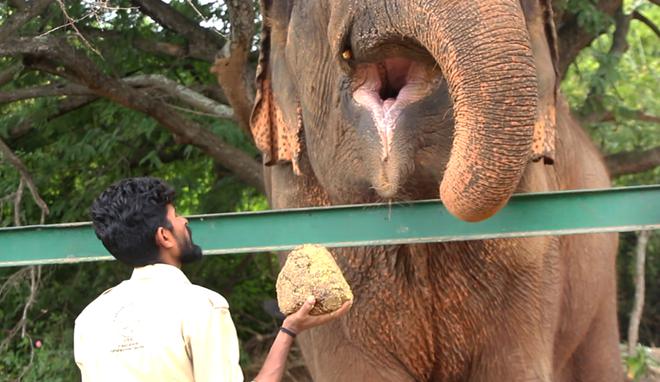
“The elephants are given roughages in the morning. Then they are showered, scrubbed, and given medications. Later on, they are given fruits and vegetables. Between 10 and 11 am we give them ragi mudde which is cooked with broken rice, horse gram, ragi powder, turmeric and green gram.”
After the morning routine, the jumbos move into the forest and graze till evening. Once back, they are given food made with rice, coconut jaggery, and a bunch of grass/palm leaves. By around 7-8 pm the elephants are back inside their sheds.
“The elephants have become more socialised now. They are physically healthy. Mentally they are relaxed, and their temperaments have reduced,” says Mr Vijaykumar.
Trumpeting resilience
It’s about 10 am and almost all the elephants have completed their morning course of shower, food, and medication. Some of them wallow in the mud in one corner of the facility, while some are getting their treatments.
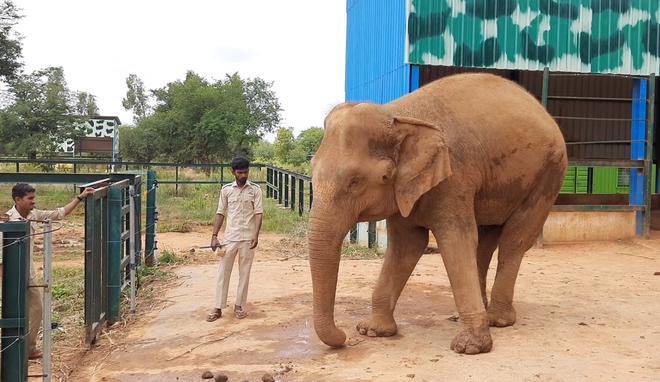
Slowly the beasts start moving, all of them. From different directions they come together to form a group, all the while trumpeting and thumping their trunks onto the floor. Some of them hold each other’s trunks or tushes briefly.
“It’s how they communicate,” says Mr Vijaykumar.
The ‘ritual’ lasts for a few minutes. Then they start moving towards the forest.
Anisha trails behind. With most legs cemented, she cannot match the pace of other elephants. Yet, she keeps at it.
A few minutes later Durga comes out of the forest and indulges in some playful moments with the staff at the facility. She doesn’t socialise much with other elephants, an imprint left upon by captivity.
Each elephant still carries such marks from the long years of confinement. Yet the resilient beasts are learning to savour every bit of the freedom they got much later in life.







